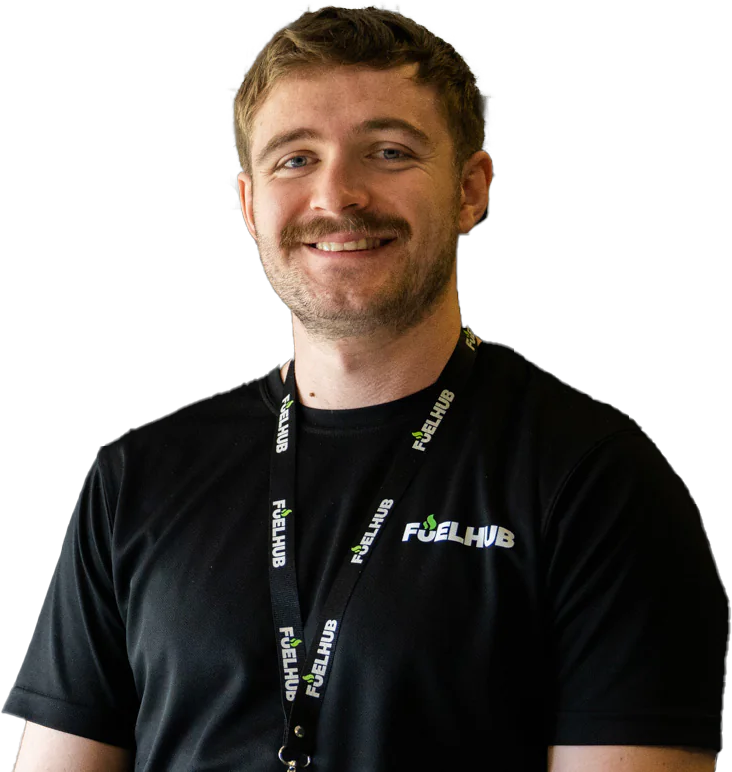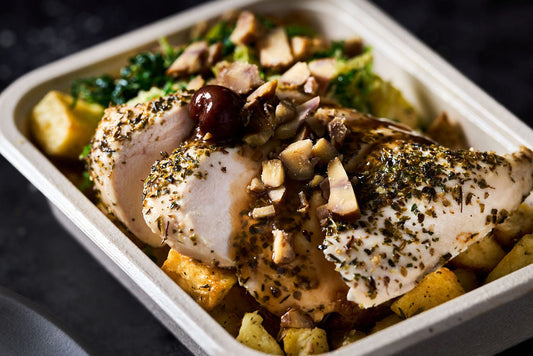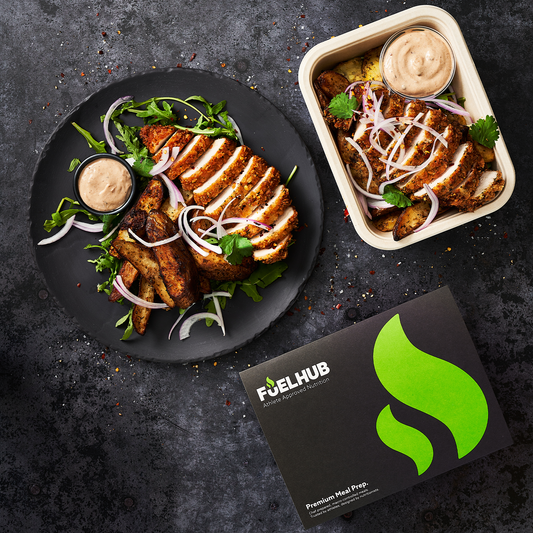Heard the phrase “bulking season” thrown around online but still not quite sure what it means? You’re not alone — the online fitness community is well and truly saturated, and knowing where to start with a muscle-gain diet isn’t easy.
Whether you’re looking to build muscle quickly, tone up through a cut, or simply maintain your gains, this guide will provide you with all the information you need. No more guesswork — just clear, actionable advice you can easily incorporate into your lifestyle. Let’s get into it.
Muscle Gain: Bulking
Bulking is a tried and tested approach to gaining muscle mass. The goal is to get bigger, and this is done through heavy lifting and eating calorie-dense foods. Here’s a quick run-through on how to get your bulk right.
Caloric surplus
Bulking doesn’t just mean lifting heavier weights — you’ll need to adopt a muscle-building diet and be in a caloric surplus to really pack on the muscle. When you eat at a caloric surplus your body goes into an anabolic state. This is a growth phase where new tissue such as muscle and bone is built up (hence the increase in “bulk”).
We recommend increasing your daily intake by a surplus of 250-500 calories over a prolonged period. This will help you steadily increase your muscle mass without feeling sluggish or stuffed 24/7.
Eating right
Not all muscle gain diets look the same — for example, there’s the controversial dirty bulk, which has a “nothing is off limits” approach to building muscle. While this approach will ensure you’re eating in that all-important surplus, it can promote unwanted fat gain, make you feel sluggish, and even increase your cholesterol and blood sugar levels.
We recommend a more balanced approach. You’ll want to prioritise complex carbs (like brown rice or quinoa), as when you’re bulking your body needs the glycogen produced by high-carb consumption to power heavy lifts. Studies have shown that the insulin spike associated with high carb intake can also promote muscle growth, so carbs should act as the foundation of your bulking diet. Top it off with lean protein, like eggs, chicken and tofu, and healthy fats (like fatty fish and avocado). Try to incorporate around 1.3-1.8g of protein per kg of your body weight to boost your gains further.
Sounds like a faff? Check out our specialised meal plan for muscle gain, nutritionist-designed to optimise your gains.
Lift heavy
Of course, another fundamental part of your bulk is lifting heavy. Aim for a moderate rep range of 8-12 reps per set to build strength and size. It’s best to focus your workouts around compound lifts like squats and bench presses — from there, you can add isolation exercises to target specific muscle groups. Remember, strength training is about progress, not perfection. Focus on steady, consistent progress over time and you’ll see the results.
Shedding Fat Cutting:
Once you’ve finished your bulk and built up your muscle mass, you might be interested in cutting. This is essentially when you “shed” the fat you’ve gained alongside the muscle during your bulk, and are left with a lean, defined physique. Here’s how to achieve a safe and effective cut:
Calorie deficit
Just as bulking requires a calorie surplus, cutting requires a calorie deficit. Consistently eating in this deficit will trigger a “catabolic state”. This is when your body doesn't receive enough energy from food, so it starts using stored fat as fuel. While this might sound intense, it's a normal part of the weight loss process. As long as you approach it sensibly, you can manage it effectively.
For an effective and maintainable cut, we recommend cutting your calorie intake by around 500 calories below maintenance. This can of course be adjusted if it feels unmanageable. Equally, you can achieve your deficit by upping your exercise instead. Ultimately, cutting (and bulking) simply comes down to calories in vs calories out — as long as more is coming out of the tank than going in, you’re achieving a cut.
Clean eating
One way to maintain this calorie deficit is by changing your diet. It can be tempting to opt for a quick-fix diet to shed weight quickly, but they tend to lack longevity and can lead to binges. It’s best to stick to clean, nutrient-rich whole foods that will make you feel good and gradually cut calories. Good things come to those who wait.
Protein will be the building block for your cutting diet. It boosts your metabolism and keeps you satiated for longer. We recommend around 1.8g of protein per kg of body weight during the cutting phase. Carbs will give you the energy you need for high-intensity workouts that aid fat loss, while healthy fats will support your hormone production and nutrient absorption.
We have a nutritionist-approved low-calorie menu specifically designed to aid weight loss in a manageable, sustainable way. For example, our Buffalo Chicken with Brown Rice & a Mixed Bean Kale Salad contains 52 grams of protein and is only 526 calories. It’s balanced, delicious, and packed with the good stuff that will make you feel your best even when you’re cutting.
High-intensity workouts and NEAT
When you’re cutting, a great way to keep that all-important calorie in/out ratio in check is by doing high-intensity workouts. Create a training routine that keeps your heart rate up and reduces rest time. Cardio (like running and cycling) is a classic, but HIIT workouts are another foolproof approach that can be easily incorporated around your schedule.
In the context of cutting, NEAT doesn’t mean being tidy. Every day, you’ll expend over a thousand calories from simply living your life. NEAT refers to the extra calories burned from being a little bit more active day-to-day, such as walking to the shops, doing a big clean, or even fidgeting! Increasing your NEAT can be a handy tool during your cut — every little helps.
Can you gain or maintain muscle while cutting?
Yes, you can gain muscle while cutting, but it's a delicate balance. This process is often referred to as body recomposition and requires a strategic approach. Here are some tips to help you maintain muscle while cutting:
-
Protein is essential for muscle repair and growth. Aim for a protein intake of around 1.6-2.2 grams per kilogram of body weight per day.
-
Strength training is crucial for preserving muscle mass. Focus on compound exercises that work multiple muscle groups, such as squats, lunges, push-ups, and rows.
-
Don't cut calories too drastically. A moderate deficit of 250-500 calories per day is generally recommended.
-
Sleep is essential for muscle recovery and growth. Aim for 7-9 hours of quality sleep per night.
-
Stress can interfere with muscle growth and recovery. Practice stress-management techniques such as yoga, meditation, or deep breathing.
Maintaining body weight and muscle mass
So, you’ve bulked through winter and cut during spring — now what? Well, if you’re happy with your physique just as it is, you might be interested in maintenance. Weight maintenance is simply maintaining your current body weight and muscle mass.
Calorie maintenance
Once you finish your bulk and cut cycle, your base calorie maintenance level might be a little different from what it was pre-bulk. Talk to a nutritionist and find out your new calorie maintenance level (the amount of calories you burn by simply being alive). That’s the base amount of calories you can eat each day without gaining or losing any weight (not accounting for any exercise).
Balanced eating
If you’re looking to maintain your current weight, you’ll want to find a balanced harmony in your diet between eating clean and feeling full. The best way to do this is by maintaining a balanced equilibrium of protein, carbohydrates and healthy fats.
Another crucial part of maintenance is listening to your body — if you’ve done a tough workout one day and are feeling especially hungry, feel free to replenish yourself until you feel full. You’re not in the cutting phase anymore!
Conclusion
Remember, the key to a successful cutting or bulking phase is finding a balance that works for you. Don't stress too much over the perfect diet or workout routine. The most important thing is to enjoy the process and make it sustainable.
And let's be honest, all the meal prepping involved in bulking and cutting can be a bit of a faff. That's why we're here at FuelHub. Our macro-balanced meal prep plans take the hassle out of healthy eating, so you can focus on what matters: crushing your goals.
Ready to fuel your journey? Check out our meal prep menu today and let us take care of the rest.



